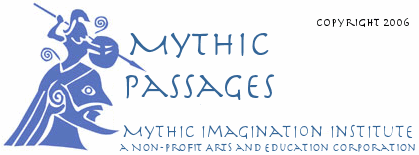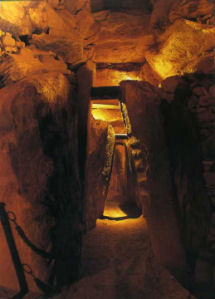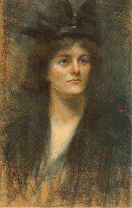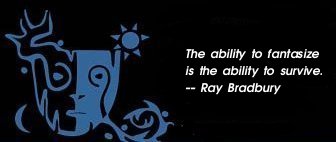|

The Wisdom of Foolishness
by James Flannery
"The Song of the Wandering Aengus" is a poem by
William Butler Yeats
(1865 — 1939) on the quest for spiritual awareness that he believed must lie at the heart of every productive and meaningful life.
I went out to the hazel wood,
Because a fire was in my head,
And cut and peeled a hazel wand,
And hooked a berry on a thread;
And when white moths were on the wing,
And moth-like stars were flickering out,
I dropped the berry in a stream,
And caught a little silver trout.
When I had laid it on the floor
I went to blow the fire aflame,
But something rustled on the floor,
And someone called me by my name;
It had become a glimmering girl
With apple blossoms in her hair
Who called me by my name and ran
And faded through the brightening air.
Though I am old and wandering
Through hollow lands and hilly lands,
I will find out where she has gone,
And kiss her lips and take her hands;
And walk among long dappled grass,
And pluck till time and times are done
The silver apples of the moon,
The golden apples of the sun.

It is impossible to grasp the full meaning of that poem on a single reading. Yet at least something of its passionate yearning
comes through — a yearning that possessed the poet from the beginning to the end of his life. It is expressed in the figurative
language that he employs to describe how difficult, yet how fundamental, is our need for communion with God. The figure of
Aengus in the title is the Celtic god of love,
and, though he moves throughout the world, his spiritual home in Ireland is a great stone cairn that pre-dates the Pyramids and is situated
on the banks of the sacred River Boyne. No one knows
how the huge stones of New Grange, the
name of the cairn, were gathered; they are not native to the place. And no one knows how it was calculated that at the Winter Solstice
— the darkest time of the year and precisely at dawn when the sun first appears over the horizon — a shaft of light
penetrates an aperture over the doorway through which one enters the passageway leading to the central chamber. Down the full
sixty-foot length of the passageway the sunlight slowly moves until the whole chamber is illuminated for seventeen minutes. Only
once a year, on each of twelve days of the solstice period, does this occur. Clearly the date of Christmas, which was not fixed
until 279 C.E., was chosen to connect the birth of the Christ child with the pagan celebration of the annual reappearance of the
sun god. And so it is that in Celtic folklore down to modern times, the birth of Christ, the "inner spiritual sun," is associated with a
great light illuminating a darkness that once covered the Earth.

But there is more to the poem — and the spiritual quest it reveals — than these explicitly Christian correspondences.
The fire within the head that leads the speaker forward is a symbol of the creative energy that longs for communion with the Divine
Imagination. Hazel woods were in pre-Christian Ireland held sacred, especially to poets, as places frequented by the Sidhe, the
fairy people of the Otherworld. Poets often carried hazel branches as symbols of their druid craft; they are the same instruments
still used by diviners when they seek underground water. The hazel berry is a symbol of fertility and of occult knowledge; the trout
a symbol of the daytime knowledge of reason, the senses and science. Suddenly, in the fifth line of the poem, the hour of day
radically changes. The flickering moth-like stars tell us it has become night — the time for another kind of knowledge, that
of dreams, poetry and the intuition. Their flickering also reminds us of the fragility of life amidst the vastness of the cosmos. And
then a miracle: the transformation of the trout into a glimmering girl with fragrant apple blossoms in her hair.
The girl who suddenly appears is a shape-changer, one of the leannan sidhe, or fairy mistresses of Celtic mythology, who
entrance men's hearts and awaken in them immortal longings for the Celtic heaven; Tir na Ban, or the "Land of Women," is one
of the synonyms for that immortal state. The scent of the apple blossoms reminds one of the connection between our immortal
longings and our sexual desires. Understood in this light, the alluring fairy woman is clearly a creature who emanates from the
Absolute. It is she, the Divine Goddess, who summons those who are disposed to heed her call on a quest for unity — not
so much of territory or politics or people — but of the body with the soul.

Interestingly, Yeats associated the scent of apple blossoms with his first meeting, in January 1889, with the love of his life,
Maud Gonne. Yeats pursued
Maud unsuccessfully through out his young manhood. But the passion of Yeats's love for Maud inspired
some of the most beautiful poetry and plays ever penned. All of this early work of the poet is suffused with an unearthly magic —
the cry of the heart and soul for transcendence:
Yet never have two lovers kissed but they
Believed some other near at hand,
And almost wept because they could not find it.
(The Shadowy Waters)
Just as night has been evoked in a few simple phrases, so in another phrase, "and ran and faded through the brightening air,"
followed by the startling line, "Though I am old and wandering through hollow land and hilly lands," an entire lifetime has passed
and we are suddenly left, like the speaker of the poem, with the memory of something supernally beautiful once experienced but
now vanished, and also with the desire to recover its numinous meaning again. Just so, we too persist along with the poet on our
own spiritual quest — a pilgrimage in which we wander the earth in search of a lost dream that, were it to be given substance,
we would embrace with the fullness of our total being. Led by a momentary flash of inspiration or illumination, we also, each in our
own way, pursue until our last dying breath the ineffable presence and mystery symbolized by the young girl — an emanation
of the Divine in mortal dress.
Again using figurative language (the only language capable of explaining mystery), the poet-speaker tells us in the last lines of
the poem what he hopes to find at the end of his pilgrimage: a spiritual awakening and an experience of wisdom that embraces the
whole of life. What the poem indicates is that such a wisdom takes two forms. The first, as symbolized by "the silver apples of the
moon," is acquired by attending to the inner life of the anima, or soul, as well as the Anima Mundi, the soul of the
world. In "the golden apples of the sun," however, we seek a form of wisdom that comes from reason, study and a lived understanding
of our own existence in the world of daily appearances, or what we usually call reality. In other words, spiritual awakening combines
two ways of being and knowing: the reality of existence and the nobility of aspiration, all in one.
The quest for spiritual awareness evoked in this marvelous vision poem of Yeats is obviously far removed from the vapid
sentimentality of New Age jargon found on the pop psychology shelves of our nation's bookstores. Nor should that quest be
equated with the strident effusions of the TV evangelists who seek to convert our souls — and dollars — to the
service of God. Still less ought the soul's longing for transcendence be confused with the feel-good panaceas delivered so
fatuously by the self-help gurus employed by PBS to win our pledge support — as if we were all mental or psychic basket
cases. Least of all does that quest have anything to do with a flag-waving "America First" jingoism that would encourage us to
exploit the resources of the planet even as we praise God for choosing us, among all the peoples of the earth, to benefit from
those riches in any way we choose. These forms of a pseudo spiritual quest are nothing more than a sham, fuelled by pretension,
hypocrisy, self interest, delusions and lies. They are also evidence of the terrible dumbing down of contemporary American culture.
That is why the work of committed artists and thinkers with authentic spiritual sensibilities holds such immense importance today.
But how can one agree even to that premise when the very word "spiritual" is fraught with a number of strangely contradictory
interpretations. We sometimes refer to the Zeitgeist, or "spirit of the times," a term that originally had metaphysical implications but
is now merely a social construct. Confucius, when asked how to serve those who "dwell in the realm of the spirits," responded, "Not
being able to serve other people, how would you be able to serve the spirits?" We talk of "team spirit" usually referring to sport,
but also to any group of people, including corporate businessmen and politicians, who have bonded together in order to achieve
certain material and mercenary goals. We talk of a "spirited person" — think of the difference of applying that to a man
versus a woman. The Irish, it is said, have a fondness for "spirits," meaning that they are prone to alcoholism. Yet the Irish word
for whisky (uisce beatha) originally meant "waters of life" — clearly quite a different concept than enjoying the state of
drunkenness. Yet again, the great Sufi poet Rumi, who founded the whirling dervishes, wrote of drunkenness as akin to mystical
ecstasy and communion with God:
Two strong impulses: One to drink long and deep,
The other not to sober up too soon.
What, after all this lexical and etymological wordplay, are we to make of a concept as central to Roman Catholic belief as the Holy
Spirit, the third person of the Blessed Trinity? As I understand it, the Holy Spirit refers to the imminent phenomenal presence of God
within the world. The term I grew up with is the Holy Ghost, but I suppose that was discarded because of its association with the
spooks and goblins of Halloween. Halloween, by the way, was originally the most sacred holiday of the Celtic year — a "hallowed
eve" when the boundaries between this and the Otherworld were dissolved and spirits walked on earth. Try explaining that to the little
"sprites" (a term that once described an elf or fairy, but now a soft drink) when they come knocking at your door for a "trick or treat"
next Halloween.
How and why have words like these lost so much of their original purpose and power? Yes, we retain some of their meaning,
but their essential spirit has long departed. That spirit must be recovered, I believe, or the essential meaning of religion itself is gone.
We all know those who profess to be deeply religious but exhibit no more palpable spirituality than a board.
Let's look at another once vital religious concept that has also lost much of its original meaning, namely the word "mystical." As
Alan Watts has said, to most people,
including many theologians, mysticism is an outmoded concept associated with "vague reasoning, with pantheism, with a distaste for
action and concrete physical life, forgetting that all these things are the freaks or aberrations of mystical religion and have nothing to
do with its essence. Its essence is a consciousness of union with God, and with that, the entire created world." In other words, to
be a mystic is to live with a conscious awareness of God's presence in every aspect of our daily lives. That's a concept with huge implications,
not only for our spiritual existence but our moral conduct as human beings.
As with mysticism, spiritual awareness is therefore not so much a matter of verbal or rational discourse as of a lived reality in which
the entire personality — mind, body, sensibility and imagination — resonates its mighty presence. The American psychologist
William James, in his classic but now neglected
study, Varieties of Religious
Experience, identified the following positive attributes as characteristics of those who have pursued active spiritual lives:
serenity, peace, simplicity, joyousness, humor, courage and, above all, a capacity to take risks and rebound from failure with a renewed
and life-affirming faith in the future. Having faced nothingness in the way of all mystical disciplines (and maybe artistic ones as well —
an idea to which I will return), by ridding the mind of unnecessary distractions such people have found God within their own beings.
They are afraid of nothing for nothing, paradoxically, has become a source of spiritual and intellectual plenitude. Think of the answers
one sometimes finds to a vexing problem in that early morning semi-conscious state between waking and sleeping and you'll recognize
something of that kind of awareness.
Yeats often wrote of such people as James describes — people who appear to think not in the mind alone but with their
whole beings. And of the powerful impact they have on others, especially in the ways they give pleasure and praise to others. These
are people who have taken a hard look at themselves, have acknowledged their failings and the wrongs they have done, and then
moved beyond solipsistic self-regard, beyond the ignominy of their own clumsiness, and beyond even remorse with all its heart-scalding
pain and guilt. All this behind them, they come at length to the celebratory state of mind that Yeats writes of in his rapturously
confessional "Dialogue of Self and Soul":
I am content to follow to its source
Every even in action or in thought:
Measure the lot: forgive myself the lot!
When such as I cast out remorse
So great a sweetness flows into the breast
That we must laugh and we must sing.
We are blest by everything,
And everything we look upon is blest.
The French performing artist and teacher Jacques Le Coq developed a rigorous methodology for training actors that sheds
considerable light on how the body and mind need to function together in creating a heightened spiritual awareness akin to blessedness.
For Le Coq, the secret of great performers lies in their ability to combine personal authenticity and creativity with extraordinary
imaginative, vocal and physical powers of expression. As a starting point to reach that goal, Le Coq devised a series of exercises
designed to enable his students to "strip away learned behavior patterns which do not belong to them, eliminating everything
which might hinder them from rediscovering life at its most authentic." Physically, the Le Coq system focuses on training the body
so as to enable budding performers to achieve a perfect alignment of their skeletal and muscular structure, thus enabling the
performers to express themselves with the utmost economy, precision, flexibility and grace. Paralleling this effort, however, are
a series of exercises focused on heightening the mental and spiritual awareness of performers. Many of these exercises involve
wearing a white neutral mask — that is, a mask which carries no expression but that of an open-eyed, perpetually curious
child. With Le Coq, the key to unlocking the creative imagination of the performer lies in identifying with, and then freeing the
innocent inner child, emblemized by the neutral mask and contained within the psyche of all human beings. Because the child
knows nothing (is a "blank page," as Le Coq puts it), everything new is experienced as an incredible discovery. As I myself have
experienced it, even a simple box can happily be explored for an hour or more, every detail of shape, weight, texture and color
examined as if under a microscope. This process of continual discovery lends an astonishing freshness and vitality to the art of
performance. But more importantly, performance becomes a means of embodying what Yeats called "a more intense and
abundant life."
Le Coq, who died in 1999, declared that his intention was to train students to be "consummate lovers of life and complete
artists on the stage." Perhaps his greatest legacy is the impressive list of internationally renowned theater companies founded by
graduates of his school: Theatre de Complicite in London, the Canadian Cirque de Soleil, the Swiss-based Mummenshanz, Le Theâtre
de Soleil in France, Theatre de la Jeune Lune in Minneapolis and New York's Big Apple Circus. In addition, the Nobel Prize winning
comedian and writer Dario Fo, the Oscar Award winning actor Geoffrey Rush, the director-playwright Steven Berkoff, the clown
Avner Eisenberg and the director-designer-puppeteer Julie Taymor are among the noted theater artists who studied with Le Coq.
In the words of Simon McBurney, the brilliant Founder and Artistic Director of Theatre de Complicite, what Le Coq offered at his
school was, "in a word, preparation... He was interested in creating a site to build on, not a finished edifice... He offered no solution.
He only posed questions."
Tragically, the commodified, hand-me-down knowledge that passes for education in contemporary America is lacking precisely
in those areas that spiritually enlightened artists have always understood and sought to express. One of the purposes of the extravagantly
polymorphous sensuality as well as the laser-beamed, deeply penetrating intellectual passion of great art is to tell the truth —
"the whole truth and nothing but the truth" — about things that people in our lobotomized culture would rather leave
unexamined. Perhaps, like our television anchors, it is thought best not to become overly excited about anything lest our complacency
be disturbed. Many of my academic colleagues suffer from the same malaise in both their personal and professional lives. That
particularly occurs when, in a pursuit of academic respectability, humanists try to apply the scientific method to everything from
the analysis of literature to the grading of kids — and thereby teaching — in our classrooms. As if the complexities
of human interaction or the pilgrimage of the individual human soul could ever be reduced to a formulaic construct. By removing
humanity from the humanities we have laid ourselves open to behavior no better than that of our purported enemies, now and
in the past.
The thirteenth century witnessed a series of bloody crusades and inquisitions led by
Pope Boniface VIII, who proclaimed that
complete subjugation to him was "utterly necessary for the salvation of every living creature." How radically different was the inclusive
spiritual awareness of Pope John XXIII, who wrote in his diary that "the whole world is my family" and, on his deathbed, smiled with
delight when a letter was read to him saying, "Insofar as an atheist can pray, I'm praying for you."
One of the heroes of John XXIII was a saintly man, also of the thirteenth century, who, in the tradition of the holy fools of
Christendom, stripped himself naked, disowned his own father in the presence of the local bishop, and identified himself with beggars,
lepers and the lowest of humankind. Traveling the roads at different times to Rome, France, Eastern Europe and Egypt, he joyfully
endured humiliation and contempt. Like so many of the holy fools of the Eastern rite (thirty of whom have been canonized as saints),
his wildness gave him a profound rapport with all living creatures: he preached to the birds, converted a wolf and, in the tradition of
the mystical pelegrini of sixth to ninth century Ireland, wandered from place to place singing praises of the wonders of the world.
I'm speaking, of that most wise and vulnerably foolish of Christian heroes, St. Francis of Assisi.
There is, of course, a long and revered tradition of saintly fools throughout the history of Christendom. St. Paul, in one of his
letters to the Corinthians, writes of the necessity of the followers of Christ to abandon the superficial cleverness, empty pride and
quarrelsome factionalizing of their worldly lives in order to embrace a different way of existence:
For consider your call, brethren: not many of you were wise according to worldly standards, not many were
powerful, not many were of noble birth; but God chose what is foolish in the world to shame the wise. God chose what is weak in the
world to shame the strong. God chose what is low and disguised in the world... to bring to nothing things that are, so that no human
being might boast in the presence of God.
Let us be clear about the message of St. Paul. He is not trivializing ignorance or stupidity, especially on the part of those who
stubbornly hold onto their own rigidly fixed ideologies, their own blinkered prejudices in the face of any dissenting arguments or proofs.
Supremely confident within their own narrow spheres of influence, the attitudes of people such as these prevent not only the growth
of individuals but undermine the social contract. In their smug self-righteousness and their failure to attend to the voices, much less the
urgent needs, of others, they choose to advance only those causes they deem worthy of attention. No, the foolishness of which St.
Paul speaks is precisely the opposite of this constricted way of functioning, for it begins, like the exercises of Jacques Le Coq, with the
experience of nothingness — meaning a humble, egoless effort to acknowledge and then nurture the hungerings of the body
and soul — as a pathway to enlightened living. Paradoxically, the pathway to a spiritual awareness that embraces the entire world
as holy — not just parts — begins with a conscious discipline of the self. That discipline involves a surrender of that part of
the self associated with willed thought and action in order to discover the far deeper awareness found within the pre-lapsarian world of
dreams, of trance, of meditation, of intuition and of ecstatic moments of vision. In short, we are talking about the peculiarly innocent
yet radically powerful awareness of the spirit known to our greatest artists and thinkers — those men and women who have
experienced for themselves the blessings of a holy form of foolishness.
Samuel Beckett, that Calvinistic witness-bearer to the
greatness and grief of Western civilization in the aftermath of the Holocaust and Hiroshima, has provided us with an enduring lesson of
hope born out of compassion and an honest recognition that we are all in it together in our mutual vulnerabilities and needs. That is
the fundamental meaning of the seemingly meaningless existence of Beckett's tortured tramps who are thrust into a blasted landscape,
presided over by a "Godot" — a deity who, although he is never physically present, nonetheless looms over them as an omnipotent
despot. Beckett's theology is the same as that of St. Francis in that, as he sees it, the sacred and the secular are knit together in the
one reality. The challenge, therefore, lies in finding an awareness of God within ourselves and others.
Yeats wrote even more explicitly out of the same mystical tradition. Several characters in his plays are called by the name of "Fool,"
including one whose natural wisdom teaches a so-called "Wise Man" that the true meaning of life is not found in formula-ridden academic
abstractions but in an awareness of the presence of divine grace within the living world. Heightening his own physical awareness as a
pathway to spiritual truth was increasingly important to Yeats the older he grew. Truth embodied thus became the major belief and theme
of his life's work, as evident in this magnificent "Prayer for Old Age" written shortly before his death:
God guard me from those thoughts men think
In the mind alone;
He that sings a lasting song
Thinks in a marrow-bone;
From all that makes a wise old man
That can be praised of all:
O what am I that I should not seem
For the song's sake a fool?
I pray — for fashion's word is out
And prayer comes round again —
That I may seem, though I die old,
A foolish, passionate man.
Interestingly, that period near the end of his life was for Yeats the most fecund and productive of his entire career. It was then that
Yeats learned how to write not so much out of deliberate effort as out of a meditative state in which all his faculties were spontaneously
accessed and engaged. Like the mystics of the early Celtic Church, Yeats sought to discipline his mind so that "the little ritual of his verse"
more and more resembled "the great ritual of nature, mysterious and inscrutable." In this way, he said, the artist is, as all the great mystics
have proclaimed, "a vessel of the creative power of God."
At the dawn of a new millennium marked by a post-modernist ethos of disillusionment and despair, it may seem foolish to dream as
the painter Wassily Kandinsky did of
a "great epoch of the Spiritual" about to be born "which will provide the soil in which a monumental work of art must come to fruition."
Today that chiliastic dream would seem far from being fulfilled. And yet, as William Blake said, "All things proceed in contraries." It may be that it is precisely out of the shattered fragments
of our modern intellectual hubris that our greatest artists and our wisest teachers will once again begin to proclaim the ancient truth best
understood by our mystics and holy fools, namely, that the way to God is by honoring and celebrating the wonder of the ordinary and
the combined spiritual and sensual nature of life itself.
In my own experience it is primarily through the visionary and transformative power of art that, as the poet
Seamus Heaney puts it,
"the space of the world" may recover its "sacred possibility." Recognizing that he was born at a time in which the world for most people
is perceived as profane rather than sacred, Heaney nonetheless continues to think of poetry as "a religious act and not its parallel."
Witness how thoroughly in an act of creative imagination he carries us into the mind and body of a sixth-century Irish saint suspended
between the claims of his earthly existence and his longing for transcendence. In "St. Kevin and the Blackbird" Heaney sketches in
masterful detail the picture of the holy man with his arms outstretched for weeks on end in sun and rain lest he disturb a mother bird
that has made a nest in his upturned palm. In the second half of the poem Heaney goes a step further, inviting us to enter into the
mental and physical agony of the saint so as to confront our own struggles with reality and faith:
And since the whole thing's imagined anyhow,
Imagine being Kevin. Which is he?
Self-forgetful or in agony all the time?
From the neck on down through his hurting forearms?
Are his fingers sleeping? Does he still feel his knees?
Or has the shut-eyed blank of underearth
Crept up through him? Is there distance in his head?
Alone and mirrored clear in love's deep river,
'To labour and not to seek reward,' he prays.
A prayer his body makes entirely
For he has forgotten self, forgotten bird
And on the riverbank forgotten the river's name.
As with Yeats, the pathway to enlightenment for Heaney is found by yielding to the inexorable power of love. Clearly, there is as
much a political as metaphysical meaning for our time in the boundless — and boundary-less — ecstasy finally experienced by St. Kevin
at the end of his agonizing, lonely quest.
Perhaps the best way to a meaningfully lived spirituality in the secular world we now inhabit is by acknowledging, as any engaged
and enlightened artist must, that the Holy Spirit dwells in the crooked as well as the straight places of the earth — places that
belong as much to the fallen as the exalted people of God's Kingdom. Our great artists might once again teach us that it is by discovering
for ourselves the holiness that radiates throughout the world, most especially in the shining eyes of our fellow creatures, that the spirit of
God may truly come to dwell with and within us.
(James Flannery, a Yeats scholar and
stage director, holds the Winship Professorship of Arts and Humanities at Emory University. This essay is based on a keynote lecture delivered
in October 2002 at Marywood University, Scranton, Pennsylvania, at an international conference on art and spirituality. He was a guest speaker
at Mythic Journeys '04, and returns this year to Mythic Journeys '06)
Return to Passages Menu
Subscribe to the Passages e-newsletter
|

